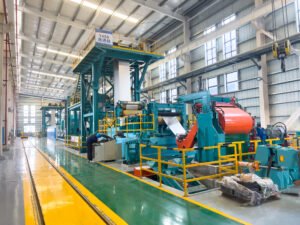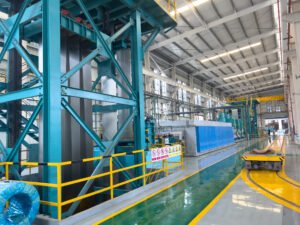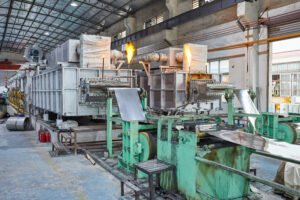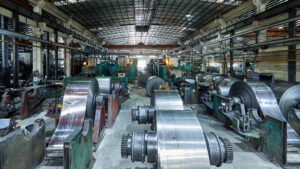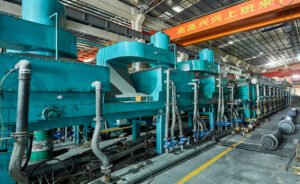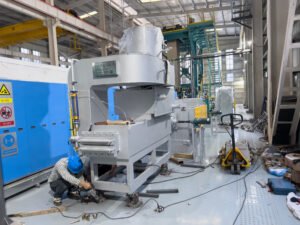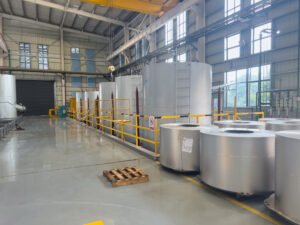Как печи отжига используются в производстве труб из нержавеющей стали?

As someone deeply involved in the heat treatment industry, I've seen firsthand the challenges manufacturers face in achieving that perfect finish and desired mechanical properties for stainless steel tubing. It's frustrating when processes lead to oxidation or inconsistent results, impacting quality and costs. Fortunately, bright annealing furnaces offer a precise, controlled solution, ensuring tubes emerge ready for demanding applications.
Bright annealing furnaces are crucial in stainless steel tubing applications for stress relieving, recrystallizing the metal to restore ductility after cold working1, and creating a smooth, oxide-free surface. This process enhances corrosion resistance and provides an aesthetically pleasing finish without requiring subsequent pickling or cleaning.
The journey of a stainless steel tube from raw material to a finished product ready for critical applications is fascinating, and bright annealing plays a pivotal role that many might underestimate. In this post, I want to share my insights from over 20 years at AKS, guiding manufacturers like Mr. Ravi Sharma in India, to explore why these furnaces are indispensable and how they tackle modern manufacturing demands.
The term "bright annealing" itself hints at its primary benefit: a lustrous, clean surface. But the science and engineering behind achieving this, especially for stainless steel tubing, goes much deeper. It's about transforming the material at a microstructural level to meet stringent performance criteria. At AKS, we've dedicated ourselves to perfecting this technology, understanding that for clients in sectors from automotive to medical, the integrity of each tube begins in the heart of the furnace. This isn't just about heating metal; it's about precision engineering to ensure that every inch of tubing meets exact specifications, whether it's for Mr. Sharma's growing stainless steel tube plant in India or a high-tech aerospace application in Europe. The controlled atmosphere, precise temperature curves, and consistent processing are all part of a complex equation we strive to solve for our clients daily.
What is the role of bright annealing furnaces in stainless steel tubing production?
I often encounter manufacturers, much like Mr. Sharma when he was initially upgrading his facility, who are aware of annealing but grapple with the specific significance of bright annealing in their stainless steel tubing lines. This uncertainty can lead to suboptimal equipment choices or process inefficiencies, ultimately affecting their product quality and bottom line. Bright annealing furnaces are specifically designed to heat treat stainless steel in a protective atmosphere, preventing oxidation and ensuring superior material properties and surface finish, which is absolutely critical.
Bright annealing furnaces play a multifaceted role in stainless steel tubing production, primarily by relieving internal stresses induced during tube forming, refining the grain structure for improved ductility and toughness, and creating a bright, oxide-free surface finish, which enhances corrosion resistance and aesthetic appeal.
Understanding this role is fundamental for any stainless steel tube producer aiming for high-quality output. It’s not just about making the tube softer; it’s about re-engineering its properties after the stresses of manufacturing processes like drawing or welding. For a business like Mr. Sharma's, which supplies stainless steel tubing to various industries, consistency in mechanical properties and surface quality is paramount. A bright annealing furnace isn't just a piece of equipment; it's a quality-defining stage in the production line. The process ensures that the tubes are not only fit for their intended purpose, whether for high-pressure applications or decorative uses, but also that they meet international standards, opening up broader market opportunities. The controlled atmosphere within the furnace, typically a mix of hydrogen and nitrogen, is key to preventing any surface scaling or discoloration, thus eliminating the need for costly and environmentally challenging post-annealing cleaning processes like pickling. This directly translates to cost savings and a more streamlined production flow, which are vital considerations for growing businesses looking to optimize their operations and improve their environmental footprint. At AKS, we've seen countless clients achieve significant improvements in their product quality and production efficiency by integrating our tailored bright annealing solutions.
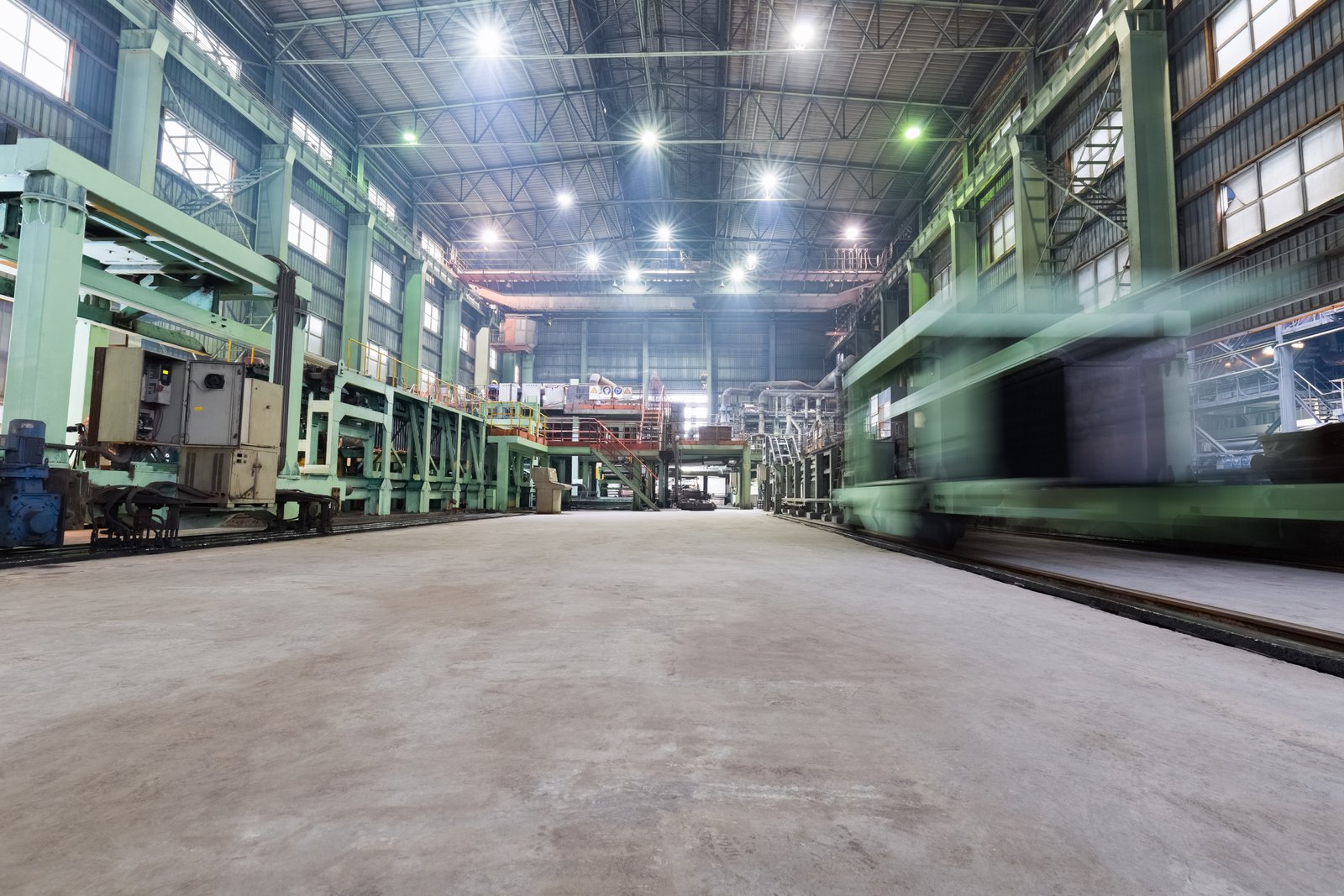
The importance of bright annealing furnaces in stainless steel tubing production cannot be overstated, as they directly influence the material's final characteristics and suitability for diverse applications. The process meticulously controls the thermal cycle and atmospheric conditions to achieve specific metallurgical transformations. This level of precision is what distinguishes high-quality stainless steel tubing in competitive markets. For manufacturers like Mr. Sharma, who values ROI and equipment performance, understanding these roles in detail helps in making informed decisions about technology adoption and process optimization. The bright annealing process ensures that the stainless steel tubes are not only aesthetically pleasing with their characteristic bright finish but are also structurally sound and possess the required mechanical and corrosion-resistant properties for their end-use. This is crucial for industries such as automotive, aerospace, medical, and food processing, where performance and reliability are non-negotiable.
Enhancing Mechanical Properties through Microstructure Refinement
One of the primary functions of bright annealing is to significantly improve the mechanical properties of stainless steel tubing, which often undergoes severe deformation during manufacturing processes like cold drawing or welding. These processes introduce internal stresses and can lead to a hardened, brittle microstructure. Bright annealing reverses these effects through recrystallization. During this stage, the furnace heats the steel to a specific temperature range (e.g., typically 1040-1150°C for austenitic stainless steels like 304 or 316L), where new, strain-free grains form and grow, replacing the deformed ones. This refinement of the microstructure results in a marked increase in ductility and toughness, making the tubes easier to bend, form, or flare in subsequent operations. For instance, a cold-worked AISI 304 stainless steel tube might see its tensile elongation increase from under 10% to over 40% after proper bright annealing, while its hardness can drop significantly, for example, from around 250 HV to 160 HV. This transformation is critical for applications requiring complex shaping or those subjected to dynamic loads.
The precise control over the annealing temperature and soaking time is paramount. If the temperature is too low or the time too short, recrystallization may be incomplete, leaving residual stresses and insufficient ductility. Conversely, excessive temperature or time can lead to grain coarsening, which can impair toughness and even surface finish. At AKS, our bright annealing furnaces are designed with multi-zone temperature control and precise atmosphere management to ensure uniform heating and optimal microstructure refinement. I recall Mr. Sharma expressing concern about achieving consistent properties for a batch of tubes destined for a high-pressure application; our solution focused on a custom-designed furnace with an optimized heating profile that ensured every tube met the stringent ductility and strength requirements. This level of control is what allows manufacturers to confidently supply tubes for critical applications where failure is not an option.
Furthermore, stress relief is an integral part of enhancing mechanical properties. Internal stresses, if not relieved, can lead to dimensional instability, distortion during subsequent machining or use, and an increased susceptibility to stress corrosion cracking, especially in aggressive environments. Bright annealing effectively eliminates these internal stresses by allowing the atoms within the steel lattice to rearrange into lower-energy, more stable configurations. This not only improves the tube's formability but also enhances its long-term performance and reliability. For stainless steel grades that are particularly prone to sensitization (like standard 304 if not cooled rapidly enough through the 450-850°C range)2, the rapid cooling capabilities often integrated into bright annealing lines are also crucial for preserving corrosion resistance alongside mechanical integrity.
Achieving Superior Surface Quality and Corrosion Resistance
The "bright" in bright annealing is a direct reference to the lustrous, scale-free surface finish achieved. This is accomplished by performing the heat treatment in a highly controlled, oxygen-free (reducing or inert) atmosphere, typically composed of pure hydrogen, a mixture of hydrogen and nitrogen (forming gas), or dissociated ammonia. By preventing oxygen from reacting with the chromium and iron on the steel's surface at elevated temperatures, the formation of oxides (scale) is completely avoided. This is a significant advantage over conventional annealing processes that require subsequent cleaning operations like pickling (using harsh acids like nitric and hydrofluoric acid) or abrasive blasting to remove scale. These cleaning processes are not only costly and time-consuming but also pose environmental and safety concerns. For example, a bright annealed surface typically exhibits a roughness (Ra) value significantly lower than that of a pickled surface, often below 0.4 µm, making it ideal for applications where smoothness is critical.
The absence of surface oxides directly contributes to enhanced corrosion resistance. The protective passive layer, primarily composed of chromium oxide3, which gives stainless steel its characteristic corrosion resistance, forms more uniformly and effectively on a clean, oxide-free surface when exposed to air after annealing. Any scale or contamination can disrupt the formation of this passive layer, creating sites for localized corrosion. For instance, studies have shown that bright annealed 316L stainless steel tubes exhibit superior resistance to pitting and crevice corrosion compared to those annealed in air and subsequently pickled, especially in chloride-containing environments common in marine, chemical processing, and medical applications. This makes bright annealed tubes particularly suitable for fluid handling systems where product purity and equipment longevity are paramount. Mr. Sharma's plant produces tubes for the food and beverage industry, where the hygienic properties afforded by a smooth, easily cleanable, and highly corrosion-resistant bright annealed surface are indispensable.
Moreover, the superior surface finish achieved through bright annealing is often a key aesthetic requirement for many applications. In architectural designs, furniture, automotive trim, and consumer appliances, the reflective and clean appearance of bright annealed stainless steel is highly valued. This eliminates the need for further polishing in many cases, reducing manufacturing steps and costs. The consistency of the bright finish across different batches, achievable with well-controlled bright annealing furnaces like those from AKS, ensures that manufacturers can meet the exacting visual standards of these markets. Our furnaces incorporate advanced atmosphere control systems, including precise gas mixing and dew point monitoring, to guarantee the optimal reducing potential required for a consistently bright and defect-free surface.
Ensuring Consistency and Uniformity in High-Volume Production
For manufacturers like Mr. Sharma, who are scaling up production and catering to diverse markets, ensuring consistent quality across large volumes of stainless steel tubing is a major operational goal. Bright annealing furnaces, particularly continuous types such as mesh belt conveyor furnaces or roller hearth furnaces, are designed to deliver this consistency. The ability to maintain precise and uniform temperature distribution throughout the heating and soaking zones of the furnace is critical. Any significant temperature variation across the tube's cross-section or along its length can lead to non-uniform recrystallization, resulting in inconsistent mechanical properties (e.g., variations in hardness or ductility) and potentially even dimensional issues like warpage. Modern bright annealing furnaces employ multiple, independently controlled heating zones, advanced temperature sensors (thermocouples), and sophisticated PID control algorithms to maintain temperature uniformity typically within ±5°C or better of the setpoint.
The continuous nature of many bright annealing processes also contributes significantly to uniformity. In a mesh belt furnace, for example, tubes pass through the heating and cooling zones at a precisely controlled speed, ensuring that each tube experiences the exact same thermal cycle. This contrasts with batch annealing processes where variations within the load can sometimes occur if not managed carefully. For industries like automotive component manufacturing or heat exchanger production, where thousands of identical tubes are required, this process consistency is vital for ensuring interchangeability and reliable performance of the final assembled product. AKS specializes in designing continuous bright annealing lines that integrate intelligent temperature control and automation, minimizing human intervention and thus reducing the potential for process variability. This allows for reliable, repeatable results, shift after shift.
Furthermore, the control over the protective atmosphere is equally crucial for consistency. Maintaining the correct dew point and gas composition (e.g., hydrogen percentage) throughout the furnace muffle is essential for preventing even slight oxidation or discoloration, ensuring every tube emerges with the desired bright finish. Any fluctuation in atmosphere quality can lead to variations in surface appearance and potentially affect corrosion resistance. Our furnaces are equipped with robust sealing mechanisms, gas pressure regulators, and often real-time atmosphere monitoring systems to ensure a stable and optimal annealing environment. This attention to detail in both thermal and atmospheric control allows manufacturers to achieve high yields of on-spec products, reducing scrap rates and rework costs. The table below illustrates typical annealing parameters that need to be consistently maintained for common stainless steel grades.
| Stainless Steel Grade | Annealing Temp. (°C) | Soaking Time (min/mm thickness) | Protective Atmosphere | Typical Cooling Method |
|---|---|---|---|---|
| AISI 304/304L | 1040 - 1120 | 1 - 2 | H₂/N₂ mix (e.g., 75% H₂, 25% N₂) or Pure H₂ | Rapid Air/Water Quench (indirect) |
| AISI 316/316L | 1050 - 1150 | 1 - 2 | H₂/N₂ mix or Pure H₂ | Rapid Air/Water Quench (indirect) |
| AISI 430 | 780 - 850 | 1.5 - 2.5 | Pure H₂ or Dissociated Ammonia | Slow Cool or Rapid Air Quench |
| Duplex 2205 | 1020 - 1100 | 1 - 2 | N₂ or H₂/N₂ mix | Rapid Water Quench |
This consistent output not only satisfies end-customer requirements but also streamlines downstream processes. Tubes with uniform mechanical properties behave predictably during fabrication, and a consistent surface finish simplifies any subsequent coating or assembly operations. For Mr. Sharma, whose goal is to be a reliable supplier, the ability to guarantee this level of consistency is a key competitive advantage, fostered by the right bright annealing technology.
Bright annealing prevents surface oxidationПравда
The controlled atmosphere in bright annealing furnaces eliminates oxygen exposure, preventing oxide formation on stainless steel surfaces.
Bright annealing reduces ductilityЛожь
Bright annealing actually increases ductility by recrystallizing the metal's microstructure after cold working processes.
How are bright annealing furnaces being used in current stainless steel tubing applications?
I find that many clients, even those experienced in metal processing, are sometimes surprised by the sheer breadth of applications where bright annealed stainless steel tubing is not just preferred but essential. It's easy to overlook how these tubes form the backbone of countless products and systems we rely on daily. The demand is driven by the unique combination of corrosion resistance, aesthetic appeal, and hygienic properties that bright annealing imparts. From critical medical devices to high-performance automotive components, these tubes are everywhere.
Bright annealing furnaces are currently used to produce stainless steel tubing for a wide array of applications, including automotive fuel and exhaust systems, medical and dental instruments, food and beverage processing lines, heat exchangers, pharmaceutical equipment, and architectural or decorative elements, where high purity, corrosion resistance, and a clean surface are paramount.
The versatility of bright annealed stainless steel tubing is truly remarkable. Consider Mr. Ravi Sharma's expanding business in India; he's looking to tap into diverse markets, each with its specific requirements. For instance, the automotive sector demands tubes that can withstand high temperatures and corrosive exhaust gases, while the food processing industry requires impeccable hygiene and resistance to various cleaning agents. Bright annealing furnaces provide the enabling technology to meet these varied specifications. The process ensures that the tubes not only perform reliably under demanding conditions but also meet stringent regulatory standards, such as those set by the FDA for food contact materials or ASTM standards for various industrial applications. Furthermore, the aesthetic quality achieved through bright annealing opens up opportunities in consumer goods and architectural design, where the visual appeal is as important as the functional properties. As technology advances and new applications emerge, the ability to produce high-quality, bright annealed stainless steel tubing efficiently and cost-effectively will continue to be a key factor for manufacturers like AKS and our clients.

The pervasive use of bright annealed stainless steel tubing across numerous industries underscores its critical role in modern manufacturing. Its application is not limited by geography; from Southeast Asia to Europe and the Americas, the demand for high-quality, corrosion-resistant, and aesthetically pleasing tubing is universal. As a manufacturer of bright annealing furnaces at AKS, I've had the privilege of working with clients like Mr. Sharma who are looking to diversify their product offerings to meet these global demands. For instance, the precision and cleanliness required for medical tubing are vastly different from the robustness needed for industrial heat exchangers, yet bright annealing is a common thread. The ability of these furnaces to handle various stainless steel grades—austenitic, ferritic, duplex—and produce tubes with specific microstructures and surface finishes makes them indispensable. This adaptability is crucial as industries evolve and demand ever-higher standards of performance, safety, and sustainability. The transition towards more sophisticated applications also means that the bright annealing process itself must be continually refined, incorporating better controls, more efficient energy usage, and automation to meet the challenges of cost, quality, and environmental responsibility.
Automotive and Aerospace Industries: Demanding Performance and Reliability
In the automotive sector, bright annealed stainless steel tubing is extensively used for critical components such as fuel lines, brake lines, hydraulic systems, and exhaust components. These applications demand exceptional corrosion resistance to withstand harsh operating environments, including exposure to road salt, moisture, and high temperatures, particularly in exhaust systems. Furthermore, the tubing must possess good formability for complex bending and shaping, along with high strength to handle pressures and vibrations. For example, stainless steel grades like 304L and 316L are commonly used for fuel lines due to their excellent resistance to fuel additives and environmental corrosion, while heat-resistant grades like 309S or 310S might be chosen for certain exhaust parts. The bright, smooth internal surface of annealed tubes also contributes to efficient fluid flow. According to a report by Grand View Research, the global automotive stainless steel tubing market size was valued at USD 3.8 billion in 2020 and is expected to grow4, driven by stricter emission norms and increasing vehicle production. This highlights the sustained demand for high-quality tubing.
Aerospace applications place even more stringent demands on materials due to extreme operating conditions and the paramount importance of safety and reliability. Bright annealed stainless steel tubes are utilized in hydraulic systems, fuel and oil lines, and structural components. These tubes must exhibit high strength-to-weight ratios, excellent fatigue resistance, and superior corrosion resistance at both high and low temperatures. Specialized stainless steel grades, including precipitation-hardening steels or specific austenitic grades, are often selected. The bright annealing process is critical to ensure that these tubes are free from surface defects that could act as stress concentrators and to achieve the precise mechanical properties required. I recall a project with a European aerospace supplier who needed exceptionally thin-walled tubes with a highly uniform grain structure for a critical sensor housing; our custom-designed AKS bright annealing furnace with advanced atmosphere control was key to meeting their tight specifications, ensuring minimal distortion and consistent metallurgical properties.
The precision required in both automotive and aerospace industries means that the bright annealing process must be meticulously controlled. Temperature uniformity, exact atmospheric composition (often pure hydrogen for critical applications to achieve the lowest possible dew point and maximum reduction potential), and controlled cooling rates are essential. Any deviation can compromise the integrity of the tube, leading to potential failures. For instance, incorrect annealing can lead to sensitization in austenitic stainless steels, reducing their intergranular corrosion resistance5, which is unacceptable for fuel lines or hydraulic systems. Therefore, furnace manufacturers like AKS invest heavily in R&D to provide equipment that offers unparalleled process control, enabling tube producers to meet the rigorous standards of these demanding sectors.
Medical, Pharmaceutical, and Food Processing: Stringent Hygiene and Purity Standards
The medical and pharmaceutical industries rely heavily on bright annealed stainless steel tubing for applications where hygiene, purity, and biocompatibility are non-negotiable. Examples include hypodermic needles, catheters, surgical instruments, and piping systems for pharmaceutical manufacturing. Stainless steel grades such as 304L, 316L, and specialized variants are preferred due to their excellent corrosion resistance to bodily fluids and aggressive cleaning/sterilization agents. The bright annealing process ensures an extremely smooth, crevice-free surface (often with Ra values < 0.5 µm, and even lower for electropolished surfaces post-annealing) which minimizes bacterial adhesion and facilitates effective cleaning and sterilization. This is critical in preventing infections and ensuring patient safety. The FDA and other regulatory bodies have strict guidelines (e.g., USP Class VI testing for biocompatibility) for materials used in medical devices, and bright annealed stainless steel often meets these requirements.
In the food and beverage processing industry, bright annealed stainless steel tubes are the standard for piping systems, heat exchangers, and equipment that comes into contact with food products. The primary concerns here are preventing contamination, ensuring easy cleanability, and resisting corrosion from food acids, cleaning solutions, and sanitizers. Grades like 304L and 316L are widely used. The smooth, non-porous surface achieved by bright annealing, often referred to as a \"sanitary finish,\" prevents food particles and microorganisms from lodging and proliferating. This is vital for maintaining product quality, safety, and shelf life. Standards such as 3-A Sanitary Standards in the US6 provide guidelines for the design and fabrication of dairy and food processing equipment, emphasizing the importance of smooth, easily cleanable surfaces. The elimination of pickling, thanks to bright annealing, also avoids any risk of residual acid contamination on the tube surface. Mr. Sharma's interest in supplying to the food processing sector in India aligns perfectly with the capabilities of modern bright annealing furnaces to produce hygienic tubing.
The consistency and reliability of the bright annealing process are crucial for these sensitive applications. Any surface imperfections, such as micro-pitting or embedded oxides, can compromise the hygienic properties of the tube. Therefore, furnaces used for these applications must provide exceptionally pure atmospheres (often requiring high-purity hydrogen and stringent dew point control, sometimes below -60°C) and precise temperature control to avoid any surface reactions or defects. The table below compares typical surface roughness (Ra) requirements for different applications, highlighting the stringent needs of the medical and food sectors.
| Application Sector | Typical Stainless Steel Grade(s) | Target Surface Roughness (Ra, µm) - Internal | Key Surface Requirement |
|---|---|---|---|
| Medical Devices (Needles) | 304L, 316LVM | < 0.25 | Extreme smoothness, biocompatibility |
| Pharmaceutical Piping | 316L | < 0.5 | High purity, cleanability, drainability |
| Food & Beverage Piping | 304L, 316L | < 0.8 | Hygienic, corrosion-resistant, non-toxic |
| Automotive Fuel Lines | 304L, 409L | < 1.0 | Corrosion resistance, smooth flow |
| General Industrial | 304 | < 1.6 | Functional, good corrosion resistance |
This attention to detail in the annealing process ensures that the final product meets the exacting standards of industries where public health and safety are paramount. AKS has a strong track record of providing furnaces that help manufacturers achieve these critical surface characteristics reliably.
Architectural, Decorative, and Consumer Goods: Aesthetics Meet Functionality
Beyond purely industrial or critical applications, bright annealed stainless steel tubing finds extensive use in architectural elements, decorative items, and consumer goods where visual appeal is a primary driver. Items such as handrails, balustrades, furniture frames, lighting fixtures, kitchen appliances, and automotive trim benefit immensely from the lustrous, reflective, and clean finish that bright annealing provides. In these markets, the \"as-annealed\" surface is often the final finish, eliminating the need for costly and labor-intensive secondary polishing operations. Stainless steel grades like 304 and, to a lesser extent, 430 (a ferritic grade that also bright anneals well) are popular choices due to their good formability, adequate corrosion resistance for these environments, and ability to achieve a high-quality bright finish.
The aesthetic consistency provided by a well-controlled bright annealing process is crucial for these applications. Architects and designers specify bright annealed stainless steel not just for its modern look but also for its durability and low maintenance requirements. Any variations in brightness, color, or surface texture would be unacceptable, especially when multiple tubes are assembled into a larger structure or product. For example, in a high-end commercial building, the handrails throughout must exhibit a uniform sheen. This places a demand on tube manufacturers to produce highly consistent material, which in turn relies on the precision of their bright annealing furnaces. The ability to control the atmosphere (e.g., hydrogen content, dew point) and temperature profile precisely ensures that each tube emerges with the same desired bright and blemish-free surface.
For manufacturers like Mr. Sharma, who might be exploring diversification into producing tubes for the burgeoning construction and consumer goods markets in regions like South Asia, having the capability to produce aesthetically superior bright annealed tubing can be a significant competitive advantage. This market segment often values the visual appeal as much as, if not more than, the ultimate mechanical properties. The \"gleam\" of stainless steel is a powerful selling point. AKS has assisted clients in optimizing their bright annealing processes specifically for decorative applications, sometimes involving specific cooling cycles or atmospheric adjustments to enhance reflectivity. The product advantage of AKS furnaces, emphasizing \"excellent durability and operational stability,\" ensures that manufacturers can consistently produce this high-value aesthetic finish, batch after batch, contributing directly to their profitability in these visually driven markets.
Bright annealing prevents surface contaminationПравда
Bright annealing in hydrogen atmosphere eliminates the need for pickling, preventing acid contamination on tube surfaces.
430 is the most common grade for medical tubingЛожь
Medical tubing primarily uses austenitic grades like 304L and 316L for their superior corrosion resistance and biocompatibility.
What challenges do manufacturers face when using bright annealing furnaces for stainless steel tubing?
While bright annealing furnaces are transformative, I know from my experience at AKS and conversations with clients like Mr. Sharma that their operation isn't without hurdles. Manufacturers often grapple with maintaining the delicate balance of atmosphere, temperature, and material handling. These operational complexities can sometimes lead to inconsistencies in product quality or unexpected downtimes if not managed proactively, impacting efficiency and profitability.
Manufacturers using bright annealing furnaces for stainless steel tubing face challenges such as maintaining strict atmospheric integrity to prevent oxidation, ensuring uniform temperature distribution for consistent metallurgical properties, managing high energy consumption, addressing muffle longevity and heating element durability, and controlling tube distortion.
These challenges are not insurmountable, but they require a deep understanding of the bright annealing process and careful attention to equipment design, operation, and maintenance. For example, Mr. Sharma has expressed concerns in the past about the "over-promised specs vs. real performance" from some suppliers, which often relates to how well a furnace can actually maintain its critical parameters under production conditions. Issues like minor air leaks into the muffle can compromise the protective atmosphere, leading to dull or oxidized surfaces instead of the desired bright finish. Similarly, inconsistent temperature zones can result in tubes with variable hardness or grain structure along their length. At AKS, we focus on robust engineering and providing comprehensive support to help our clients navigate these potential pitfalls, ensuring they can leverage the full benefits of bright annealing technology without being bogged down by operational issues.

Addressing the challenges inherent in bright annealing is a continuous focus for both furnace manufacturers like us at AKS and the stainless steel tube producers we serve. These are not just theoretical problems; they have real-world consequences on production costs, product quality, and ultimately, a manufacturer's reputation. Mr. Sharma's pain point about "high energy costs affecting production margins" is a common concern across the industry, pushing us to develop more energy-efficient furnace designs. Similarly, the need for "equipment durability" highlights the importance of robust construction and reliable components to minimize maintenance and ensure long service life. Understanding these challenges in depth allows us to engineer better solutions and provide more effective support. For instance, preventing tube distortion, especially for thin-walled or long tubes, requires careful consideration of support mechanisms within the furnace and controlled heating/cooling rates. Each challenge presents an opportunity for innovation and improvement, driving the technology forward to deliver even greater value to manufacturers.
Maintaining Protective Atmosphere Integrity and Purity
A primary challenge in bright annealing is the continuous maintenance of a high-purity protective atmosphere within the furnace muffle or chamber. The entire principle of "bright" annealing hinges on preventing any reaction between the hot stainless steel surface and oxygen or water vapor. Even trace amounts of contaminants can lead to discoloration, partial oxidation, or a dull finish, negating the benefits of the process. The typical protective atmospheres used, such as dry hydrogen, hydrogen-nitrogen mixtures (forming gas), or dissociated ammonia7, must be supplied at the correct purity and flow rate, and the furnace must be exceptionally well-sealed to prevent air ingress. Common sources of contamination include leaks in the muffle, seals at the entry and exit points, or impurities in the gas supply itself. For instance, a dew point consistently above -40°C in a hydrogen atmosphere can start to cause issues for more sensitive stainless steel grades, while ideal conditions often call for dew points below -60°C.
Achieving and maintaining such low dew points and oxygen levels (often in the parts-per-million range) requires meticulous furnace design and operation. The muffle, typically made from high-temperature alloys like Inconel or specific refractory steels, must be crack-free and gas-tight. Seals at the furnace ends, where tubes enter and exit, are critical and can be a point of failure; these often involve fiber curtains, nitrogen gas curtains, or sophisticated labyrinth seals. Mr. Sharma's concern about "over-promised specs vs. real performance" is particularly relevant here, as some furnace designs may struggle to maintain atmosphere integrity under continuous production pressures. At AKS, our furnaces feature robust muffle construction, advanced sealing technologies, and integrated atmosphere monitoring systems (e.g., oxygen analyzers and dew point sensors) to provide real-time feedback and control, helping to ensure the protective atmosphere's purity is consistently maintained. This proactive monitoring allows operators to detect and address potential issues before they impact product quality.
Furthermore, the management of gas flow dynamics within the furnace is also crucial. Sufficient positive pressure must be maintained to prevent air from being drawn in, but excessive flow can be wasteful and increase operational costs. The furnace design should promote even distribution of the protective gas throughout the annealing chamber, ensuring all surfaces of the tubes are adequately protected. Burn-off pilots at the furnace exits are used to safely ignite escaping hydrogen, also serving as a visual indicator of positive pressure. The choice of gas itself also presents considerations: pure hydrogen offers the best reducing potential but requires stringent safety protocols, while nitrogen-hydrogen mixtures are safer but may be less effective for certain alloys or require higher purity levels. Dissociated ammonia (75% H₂, 25% N₂) is a cost-effective alternative but requires an on-site ammonia dissociator. Addressing these atmospheric challenges is fundamental to successful bright annealing.
Achieving and Sustaining Precise Temperature Uniformity
Another significant challenge is achieving and maintaining precise temperature uniformity throughout the heating and soaking zones of the furnace, as well as across the cross-section of the tubes being processed. Stainless steel's metallurgical properties are highly sensitive to temperature variations. Non-uniform heating can lead to inconsistent grain size, hardness, and mechanical strength within a single tube or between different tubes in a batch. For example, if one side of a tube is hotter than the other, or if tubes at the edge of a bundle are cooler than those in the center (in a batch furnace), the resulting properties will vary, potentially leading to product rejection or failure in service. For continuous furnaces, maintaining uniformity along the length of the heating zone is critical to ensure each part of the tube receives the correct thermal cycle. Typically, a uniformity of ±5°C to ±10°C relative to the setpoint is required for high-quality bright annealing.
Several factors contribute to temperature non-uniformity. These include the design and placement of heating elements, the effectiveness of furnace insulation, the circulation of the protective atmosphere (which also plays a role in heat transfer), and the thermal mass of the tubes themselves. Thin-walled tubes heat up quickly, while thick-walled tubes require longer soaking times to ensure the core reaches the target temperature. Overcoming these challenges requires sophisticated furnace design. At AKS, our furnaces utilize multiple, independently controlled heating zones, each with its own thermocouple and PID (Proportional-Integral-Derivative) controller8. This allows for fine-tuning of the temperature profile along the furnace length. Strategic placement of high-quality heating elements and the use of advanced insulation materials minimize heat loss and help create a stable thermal environment. For certain applications, forced convection using atmosphere circulation fans (designed for high-temperature, reducing atmospheres) can further enhance temperature uniformity, especially for densely packed loads or larger diameter tubes.
The impact of temperature non-uniformity on final product quality can be illustrated by considering grain growth. If some parts of a tube are overheated, excessive grain growth can occur, leading to reduced toughness and a poorer surface finish (e.g., "orange peel" effect after forming). Conversely, under-annealed sections will retain internal stresses and have insufficient ductility. The table below provides a qualitative view of how temperature deviations can affect key properties. Ensuring consistent temperature is therefore not just about meeting a specification; it's about guaranteeing the functional integrity and processability of the stainless steel tubing. Regular calibration of thermocouples and validation of furnace temperature profiles (e.g., through furnace surveys) are essential maintenance practices.
| Параметр | Temperature Too Low | Temperature Too High | Optimal Temperature |
|---|---|---|---|
| Grain Size | Fine, potentially incompletely recrystallized | Coarse, potential for excessive grain growth | Uniform, fine to medium recrystallized grains |
| Ductility | Lower, due to incomplete stress relief/recrystallization | Generally good, but can decrease if excessively coarse | Optimal, good formability |
| Твердость | Higher than desired | Lower, potentially too soft | Within specified range |
| Corrosion Res. | May be compromised if sensitization occurs (in some grades) | May be compromised by surface reactions if atmosphere is poor | Optimal, especially if rapid cooling prevents sensitization |
| Отделка поверхности | May show residual effects of cold work | Risk of "orange peel" if grains are too coarse | Smooth, bright |
Managing Energy Consumption and Operational Costs
Bright annealing furnaces, like most heat treatment equipment, are significant energy consumers. The need to heat stainless steel tubes to high temperatures (often exceeding 1000°C) and maintain these temperatures for specific durations translates directly into substantial electricity or gas consumption. This high energy usage is a major operational cost for manufacturers and directly impacts their profit margins, a key concern for clients like Mr. Sharma. Moreover, with increasing global focus on sustainability and reducing carbon footprints, the energy efficiency of industrial processes is under greater scrutiny. Therefore, minimizing energy consumption without compromising the quality of the annealing process is a critical challenge.
Several factors contribute to the energy demands of bright annealing furnaces. Heat losses through the furnace walls, roof, and hearth are a primary concern, even with good insulation. Heat is also lost via the exiting hot tubes and the continuous flow of the protective atmosphere, which must be heated to the furnace temperature. The efficiency of the heating elements themselves and the overall design of the heat transfer mechanisms also play a role. Inefficient designs can lead to longer cycle times or require higher power inputs to achieve the desired temperatures and uniformity. For electrically heated furnaces, the cost of electricity is a direct operational expense, while for gas-fired furnaces (less common for muffle-type bright annealing due to atmosphere control challenges, but used in some direct-fired open annealing), fuel costs and burner efficiency are key.
At AKS, we are acutely aware of this challenge and incorporate several energy-saving technologies and design principles into our furnaces. This includes using advanced, multi-layer insulation materials with low thermal conductivity to minimize heat loss through the furnace structure. We optimize heating element design and placement for maximum thermal efficiency and rapid heat transfer to the workload. For continuous furnaces, energy recovery systems9 can sometimes be implemented, such as preheating the incoming tubes or the protective atmosphere using the heat from the exiting hot tubes or flue gases (though the latter is more complex in protective atmosphere furnaces). Intelligent control systems that optimize heating cycles based on the load size and material type can also contribute to energy savings by avoiding unnecessary overheating or prolonged soaking times. Mr. Sharma's preference for "high-efficiency, energy-saving solutions" is a common driver for innovation in this area, and we continually strive to improve the energy performance of AKS furnaces, helping our clients reduce their operational costs and environmental impact.
Bright annealing requires protective atmosphereПравда
The process relies on oxygen-free environments (like hydrogen or nitrogen mixtures) to prevent oxidation and maintain stainless steel's bright surface finish.
Temperature uniformity isn't criticalЛожь
Precise temperature control (±5-10°C) is essential as variations cause inconsistent grain structure, hardness, and surface quality in stainless steel tubes.
What strategies can be employed to overcome these challenges in stainless steel tubing production?
Facing the operational complexities of bright annealing10 can seem daunting, but as a long-time furnace manufacturer, I can assure you they are manageable. Ignoring them leads to inefficiencies, inconsistent quality, and ultimately, higher costs. The key is a proactive and strategic approach, combining the right equipment with smart processes and diligent upkeep to transform these challenges into manageable aspects of a high-performing production line.
Strategies to overcome bright annealing challenges include investing in high-quality, well-designed furnaces with precise atmosphere and temperature controls, implementing rigorous process monitoring and quality assurance protocols, adhering to regular preventive maintenance schedules, and providing comprehensive operator training to ensure consistent and efficient operations.
For instance, when Mr. Ravi Sharma decided to upgrade his stainless steel tube production, his focus was not just on acquiring a furnace but on finding a solution that addressed his specific pain points, such as energy efficiency and reliable performance. This meant looking beyond the initial purchase price to consider the total cost of ownership and the long-term support offered by the supplier. By selecting an AKS furnace designed for optimal atmosphere integrity and temperature uniformity, coupled with a robust maintenance plan and training for his team, he was able to significantly improve his product quality and operational efficiency. This holistic approach is what truly makes a difference. It's about creating a synergistic system where advanced technology, well-defined procedures, and skilled personnel work together to achieve the desired outcomes consistently. The journey to mastering bright annealing involves continuous learning and adaptation, but the rewards in terms of product excellence and market competitiveness are substantial.
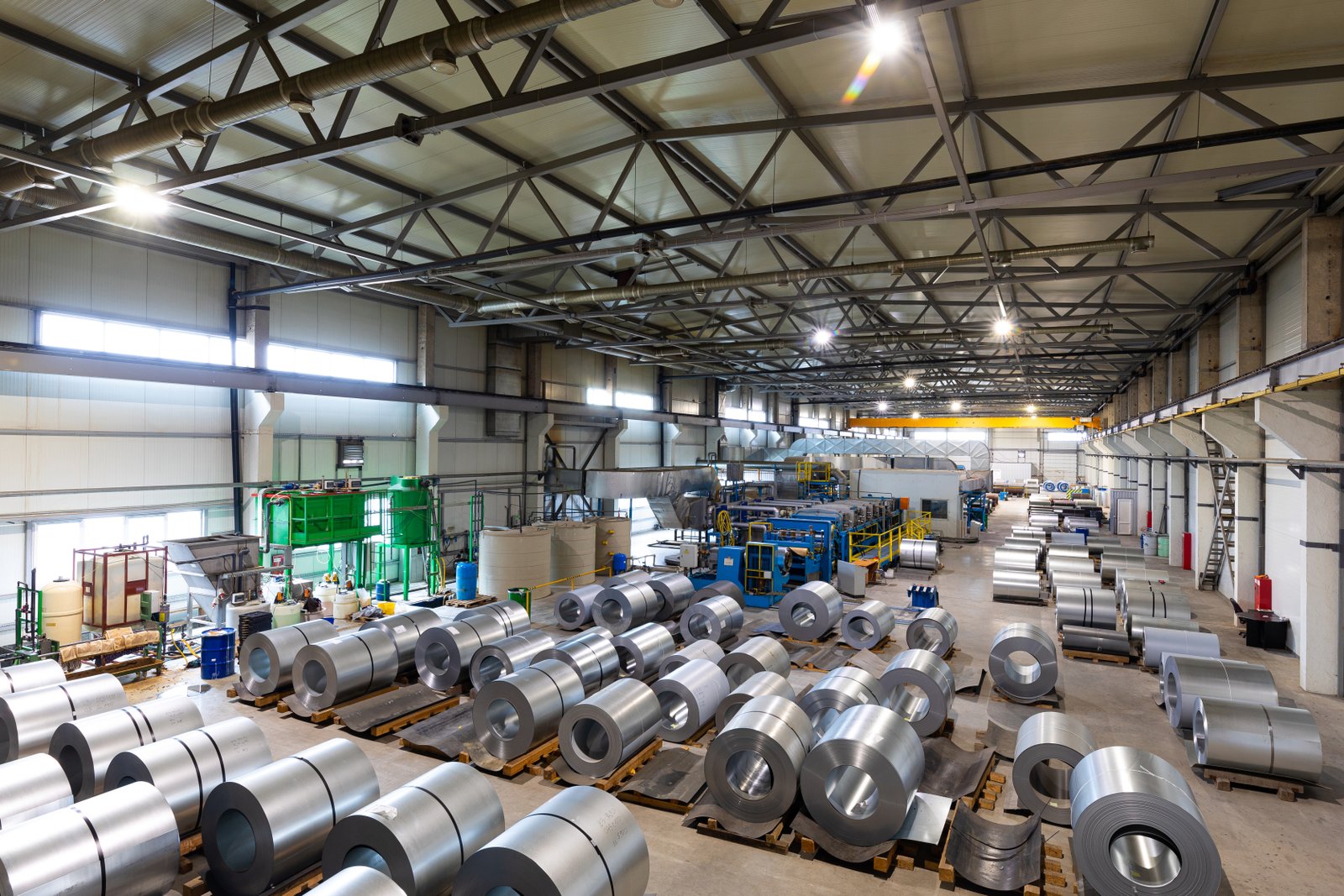
Effectively overcoming the challenges in bright annealing of stainless steel tubing requires a multi-faceted strategy that encompasses technology, process control, and human expertise. It's not enough to simply purchase a furnace; manufacturers must actively engage in optimizing its use and upkeep. For Mr. Sharma, whose business relies on producing high-value stainless steel tubing, implementing such strategies is directly linked to his company's profitability and reputation. The emphasis on \"short delivery time\" and \"equipment durability\" in his sourcing key points underscores the need for reliable and efficient operations, which can only be achieved by systematically addressing potential issues. From our perspective at AKS, partnering with clients means not just supplying equipment but also sharing knowledge and best practices to help them establish these crucial strategies. This collaborative approach ensures that the sophisticated features of our furnaces are fully leveraged to mitigate common challenges and achieve superior results in stainless steel tubing production.
Investing in Advanced Furnace Technology and Customization
A cornerstone strategy for overcoming bright annealing challenges is the initial investment in advanced furnace technology that is specifically designed to address known issues. This means selecting furnaces equipped with state-of-the-art systems for temperature control, atmosphere management, and overall robust construction. For example, furnaces with multi-zone PID temperature control, high-velocity atmosphere circulation (where appropriate), and sophisticated sealing mechanisms are better equipped to maintain temperature uniformity and atmosphere integrity. AKS product advantages like \"high thermal efficiency,\" \"intelligent control systems with easy operation,\" and \"excellent durability\" directly address these needs. When Mr. Sharma was looking to upgrade, his interest in a \"customized Bogie Hearth Furnace for batch heat treatment\" alongside a continuous bright annealing line highlighted the importance of tailoring equipment to specific production requirements. Customization allows for the optimization of furnace dimensions, heating capacity, and handling systems to match the product mix and throughput needs, which can significantly improve efficiency and reduce the likelihood of problems like tube distortion or inconsistent heating.
Investing in technology also includes considering the materials of construction for critical furnace components like the muffle and heating elements. High-quality, corrosion-resistant alloys for muffles (e.g., Inconel 601 or similar11) can extend service life and reduce the risk of leaks that compromise the protective atmosphere. Similarly, durable heating elements designed for long life at high temperatures minimize downtime and replacement costs. Mr. Sharma’s sourcing key point regarding \"equipment durability and energy consumption rate\" reflects a common industry need for furnaces that are not only effective but also economical to operate over the long term. Furthermore, modern furnaces often come with advanced PLC-based control systems that offer data logging, recipe management, and remote diagnostic capabilities. These features provide valuable insights into the process, facilitate troubleshooting, and help in maintaining consistent quality, directly addressing the pain point of \"over-promised specs vs. real performance\" by providing transparent operational data.
The \"in-house R&D and technical engineering team\" at AKS plays a crucial role here. We work closely with clients to understand their unique challenges and production goals. This allows us to recommend or custom-design furnaces that are not just fit-for-purpose but are also engineered to preemptively tackle common bright annealing issues. For example, if a client is processing very thin-walled tubes prone to distortion, our design might incorporate specialized support systems within the muffle or a more gentle heating profile. This proactive approach, focusing on a \"fully customizable design and configurations,\" ensures that the furnace itself becomes a solution rather than a source of challenges.
Implementing Rigorous Process Control and Quality Assurance
Even the most advanced furnace requires meticulous process control and robust quality assurance (QA) procedures to consistently deliver high-quality bright annealed tubing. This strategy involves defining optimal annealing parameters for each stainless steel grade and tube dimension, and then diligently monitoring and controlling these parameters during production. Key process variables include the temperature profile (heating rate, soaking temperature, soaking time, cooling rate), atmosphere composition (e.g., H₂/N₂ ratio, dew point, oxygen content), and, for continuous furnaces, the conveyor speed. Implementing a system for regular calibration of all critical sensors—thermocouples, gas analyzers, flow meters—is essential for accurate control. Mr. Sharma’s technical background makes him appreciate the value of such precision.
Rigorous process control extends to the incoming material and the setup of each production run. Ensuring that tubes are clean and free from lubricants or contaminants before entering the furnace is vital, as residues can vaporize and contaminate the furnace atmosphere or react with the tube surface. Documented standard operating procedures (SOPs) for furnace startup, operation, and shutdown help ensure consistency across different shifts and operators. The use of data logging capabilities in modern furnace control systems allows for the tracking of process parameters for each batch or run. This data is invaluable for quality assurance, enabling traceability and facilitating root cause analysis if any deviations in product quality occur. For example, if a batch of tubes shows signs of slight oxidation, reviewing the dew point and oxygen level logs for that run can help pinpoint the issue.
Quality assurance protocols should include regular testing of the annealed tubes to verify that they meet the required specifications. This typically involves hardness testing, tensile testing (for strength and ductility), visual inspection for surface brightness and defects, and sometimes microstructural examination. The frequency and type of testing will depend on the criticality of the application and customer requirements. Establishing clear acceptance/rejection criteria is also important. The table below outlines some recommended process control parameters and corresponding QA checks for bright annealing SS304 tubes, a common grade Mr. Sharma might process. This systematic approach to process control and QA minimizes variability, reduces scrap rates, and ensures that the final product consistently meets customer expectations.
| Process Parameter | Target Value/Range (SS304) | Monitoring Method | QA Check | Acceptance Criteria (Example) |
|---|---|---|---|---|
| Soaking Temperature | 1050 - 1100 °C | Thermocouples, PID | Hardness Test | < 180 HV |
| Atmosphere Dew Point | < -50 °C | Dew Point Sensor | Visual Inspection | Bright, no discoloration |
| Atmosphere O₂ Content | < 10 ppm | Oxygen Analyzer | Visual Inspection | Bright, no oxidation |
| H₂ in H₂/N₂ Atmosphere | 25% - 75% (or 100% H₂) | Gas Flow Meters/Analyzer | Microstructure Exam (occasional) | Recrystallized, equiaxed grains |
| Conveyor Speed (Continuous) | Varies (e.g., 0.5 - 2 m/min) | Speed Sensor | Tensile Test | Elongation > 40% |
Prioritizing Regular Maintenance and Comprehensive Operator Training
A proactive and thorough maintenance program is crucial for the long-term reliability and optimal performance of bright annealing furnaces. This strategy moves beyond reactive repairs to scheduled preventive maintenance, aiming to identify and address potential issues before they cause breakdowns or compromise product quality. Key maintenance activities include regular inspection of the muffle for cracks or distortion, checking heating elements for wear or damage, ensuring the integrity of furnace seals, calibrating sensors, and verifying the proper functioning of the atmosphere control system. Mr. Sharma's pain point regarding \"poor after-sales communication from some suppliers\" highlights the need for suppliers like AKS to provide not just durable equipment but also guidance on effective maintenance practices and readily available spare parts.
A comprehensive maintenance schedule should be developed based on the furnace manufacturer's recommendations and operational experience. This might include daily checks (e.g., visual inspection of flame curtains, gas pressures), weekly checks (e.g., seal integrity, thermocouple readings), and less frequent but more thorough inspections (e.g., muffle integrity, insulation condition). Keeping detailed maintenance logs helps track the furnace's condition over time and can inform decisions about component replacement or refurbishment. For instance, regularly monitoring the power consumption of individual heating zones can indicate a failing element before it burns out completely, allowing for planned replacement during scheduled downtime. This focus on \"equipment durability\" is a shared goal for both the manufacturer and the furnace supplier.
Equally important is comprehensive training for furnace operators and maintenance staff. Operators need to understand the principles of bright annealing, the critical process parameters, and how to correctly operate the furnace controls. They should be trained to recognize early warning signs of potential problems, such as changes in surface finish, unusual noises, or fluctuations in temperature or atmosphere readings. Training should also cover safety procedures, especially when dealing with flammable gases like hydrogen12. Well-trained maintenance personnel are essential for performing inspections, troubleshooting issues, and carrying out repairs effectively. AKS often provides on-site training and detailed operational/maintenance manuals as part of our service. This investment in human capital ensures that the sophisticated technology of the bright annealing furnace is operated and maintained correctly, maximizing its lifespan and performance, and directly addressing concerns about reliable, long-term operation.
Customization improves furnace efficiencyПравда
Tailoring furnace dimensions and heating capacity to specific production needs reduces tube distortion and improves heating consistency.
Maintenance is only needed when problems occurЛожь
Proactive preventive maintenance schedules are crucial to identify issues before they cause breakdowns or quality problems.
Which technological advances could improve bright annealing furnace applications in the future?
As someone who has been immersed in furnace technology for over two decades at AKS, I'm constantly looking towards the horizon. While today's bright annealing furnaces are highly capable, the pursuit of greater efficiency, precision, and intelligence never stops. It's exciting to consider how emerging technologies could further refine this critical process, addressing current limitations and unlocking new possibilities for stainless steel tubing manufacturers.
Future technological advances poised to improve bright annealing furnace applications include enhanced real-time sensor integration for dynamic process control13, AI-driven predictive analytics for optimization and fault prevention14, development of more energy-efficient heating elements and insulation, and increased automation for 'lights-out' operation15.
Imagine a bright annealing line where sensors continuously analyze the tube's surface chemistry and microstructure inside the furnace, with an AI system making micro-adjustments to temperature and atmosphere in real-time to guarantee perfect results for every inch of tubing. This isn't science fiction; it's the direction in which the industry is heading. For clients like Mr. Sharma, who are always seeking better ROI and higher quality, these advancements promise reduced energy consumption, lower scrap rates, and even more consistent product characteristics. At AKS, our R&D team is actively exploring some of these avenues, because we believe that the future of heat treatment lies in smarter, more adaptive, and more sustainable technologies. The goal is to make the bright annealing process not just a step in manufacturing, but a truly intelligent and optimized value-adding operation.

The evolution of bright annealing technology is driven by the persistent industry demands for higher quality, greater efficiency, lower operational costs, and increased sustainability. As manufacturers like Mr. Sharma seek to expand their capabilities and enter more demanding markets, the limitations of current technologies become more apparent, fueling the quest for innovation. From my vantage point at AKS, I see several key areas where technological breakthroughs are likely to have a significant impact. These advancements are not just incremental improvements; they have the potential to fundamentally change how bright annealing is performed, making it more data-driven, autonomous, and environmentally friendly. The integration of digital technologies, advanced materials science, and sophisticated modeling techniques will be pivotal in shaping the next generation of bright annealing furnaces, offering unprecedented levels of control and performance to stainless steel tube producers worldwide.
Enhanced Sensor Integration and Real-Time Process Monitoring
The future of bright annealing will likely see a proliferation of advanced, integrated sensors providing far more granular, real-time data about both the furnace environment and the material being processed. Current systems rely heavily on thermocouples for temperature and analyzers for bulk atmosphere composition (e.g., O₂, H₂, dew point). Future furnaces could incorporate in-situ sensors capable of analyzing the surface chemistry of the stainless steel tube as it passes through the furnace. For instance, techniques like Laser-Induced Breakdown Spectroscopy (LIBS) or advanced optical emission spectroscopy could potentially provide real-time feedback on surface oxidation levels or even changes in elemental composition at the surface, allowing for immediate adjustments to the atmosphere or temperature to correct any deviations. This would move beyond simply controlling the environment to directly monitoring and controlling the desired outcome on the material itself.
Furthermore, non-contact temperature sensing technologies, such as advanced pyrometers capable of accurately measuring emissivity changes on the bright stainless steel surface, could offer more precise tube temperature readings compared to relying solely on zone thermocouples, which measure furnace atmosphere temperature. Innovations in sensor technology could also extend to real-time grain size monitoring, perhaps using ultrasonic techniques or sophisticated image analysis through specially designed viewports. Imagine a system that could confirm complete recrystallization and optimal grain size before the tube even exits the cooling zone. Such data would allow for dynamic process adjustments, ensuring every tube meets exacting metallurgical specifications. For example, if sensors detect incomplete recrystallization in a section of tubing, the system could subtly increase soak time or temperature for that specific segment, optimizing material properties on the fly. This level of responsiveness is a significant leap from current recipe-based processing.
At AKS, we recognize the potential of such advanced sensor suites. While challenges exist in developing sensors that can withstand the harsh furnace environment (high temperatures, reducing atmospheres) and provide reliable, continuous data, the benefits are compelling. This data-rich environment would not only improve process control but also provide invaluable information for predictive maintenance (e.g., detecting early signs of muffle degradation or heating element failure) and for building more accurate digital twins of the annealing process. This would enable manufacturers like Mr. Sharma to achieve unprecedented levels of quality consistency and operational insight, reducing their reliance on post-process inspection and significantly lowering defect rates.
AI and Machine Learning for Predictive Control and Optimization
The vast amounts of data generated by enhanced sensor arrays will pave the way for the widespread adoption of Artificial Intelligence (AI) and Machine Learning (ML) in bright annealing operations. AI algorithms can analyze complex datasets from multiple sensors in real-time, identifying patterns and correlations that might be invisible to human operators or traditional control systems. This capability can be harnessed for predictive control, where the AI anticipates potential deviations from optimal conditions and proactively adjusts process parameters—such as temperature setpoints, atmosphere flow rates, or conveyor speed—to prevent defects before they occur. For example, an ML model trained on historical data could predict the likelihood of surface discoloration based on subtle changes in dew point, gas impurity levels, and tube surface temperature, then trigger corrective actions.
Beyond real-time control, AI and ML can be used for long-term process optimization. By analyzing months or years of production data, including furnace parameters, material inputs, and quality outcomes, ML algorithms can identify the optimal combination of settings to achieve specific targets, such as minimizing energy consumption per ton of product, maximizing throughput while maintaining quality, or extending the life of furnace components like muffles. This could lead to the development of "intelligent recipes" that adapt to variations in incoming material or ambient conditions. Mr. Sharma's focus on ROI and efficiency would be directly supported by such systems, which promise to squeeze more value out of every operational hour. The table below outlines some potential AI applications and their benefits in the context of bright annealing.
| AI Application Area | Description | Potential Benefits |
|---|---|---|
| Predictive Maintenance | ML models analyze sensor data to predict component failure (e.g., muffle, elements). | Reduced unplanned downtime, optimized maintenance schedules, extended component life. |
| Dynamic Process Control | AI adjusts parameters in real-time based on sensor feedback and predictions. | Improved product consistency, reduced defects/scrap, optimized cycle times. |
| Energy Optimization | ML identifies optimal settings to minimize energy use per unit of production. | Lower energy costs, reduced carbon footprint, improved sustainability. |
| Quality Prediction | AI predicts final product quality based on in-process data. | Early detection of potential quality issues, reduced need for extensive post-inspection. |
| Recipe Optimization | ML analyzes historical data to refine and adapt annealing recipes. | Enhanced material properties, adaptation to new alloys or varying input material. |
The implementation of AI in bright annealing also promises to reduce the reliance on highly experienced operators for fine-tuning the process. While human expertise will always be valuable, AI can act as a powerful assistant, providing data-driven recommendations and automating routine adjustments. This can lead to more consistent operations, especially across different shifts or in facilities with a less experienced workforce. AKS is exploring how AI can be integrated into our furnace control systems to provide these advanced capabilities, ultimately empowering our clients to achieve new levels of operational excellence.
Innovations in Heating Technology and Sustainable Operations
Future bright annealing furnaces will undoubtedly benefit from innovations in heating technology aimed at improving energy efficiency, temperature uniformity, and reducing environmental impact. While conventional metallic heating elements and gas-fired radiant tubes (in some designs) are mature technologies, research continues into more advanced materials and methods. For example, silicon carbide (SiC) or molybdenum disilicide (MoSi₂) heating elements offer higher operating temperatures, longer life, and potentially better energy efficiency in certain applications compared to traditional metallic elements. The development of novel ceramic composite materials could lead to even more robust and efficient heating elements. Furthermore, advancements in induction heating technology, if adaptable to the continuous, controlled-atmosphere environment of bright annealing for certain tube profiles, could offer very rapid and localized heating, potentially reducing overall energy use and furnace footprint.
Another key area is the improvement of furnace insulation. The development of nano-structured insulation materials or advanced aerogels could offer significantly better thermal resistance than current ceramic fiber or brick insulation, leading to drastically reduced heat losses through the furnace walls. This would directly translate to lower energy consumption and a cooler ambient environment around the furnace. AKS is committed to incorporating "energy-saving and environmentally friendly technologies" into our designs. This includes not only exploring new materials but also optimizing furnace geometry and heat recovery systems. For instance, more efficient heat exchangers to preheat the incoming protective atmosphere or even the tubes themselves, using waste heat from the cooling zone, could yield substantial energy savings.
The drive for sustainable operations also extends to the protective atmospheres used. While hydrogen is an excellent reducing agent, its production (if from fossil fuels) has a carbon footprint, and its flammability requires careful management. Research into optimizing nitrogen-hydrogen mixtures to use less hydrogen while maintaining effectiveness, or exploring alternative non-flammable or more easily generated inert/reducing atmospheres for specific stainless steel grades, could be beneficial. There's also ongoing interest in "green hydrogen" produced via electrolysis using renewable energy; as this becomes more cost-effective, it would make hydrogen-based bright annealing a truly carbon-neutral process. These innovations in heating and atmosphere technology will be crucial for making bright annealing not only more effective and efficient but also more aligned with global sustainability goals, a factor of increasing importance to forward-thinking manufacturers like Mr. Sharma.
AI can optimize bright annealing processesПравда
AI can analyze sensor data to predict and prevent defects, optimize energy use, and improve overall process efficiency in bright annealing.
Current furnaces directly monitor material surface chemistryЛожь
Current systems mainly monitor furnace environment parameters; future systems may incorporate in-situ surface chemistry analysis but this is not standard practice yet.
Заключение
Bright annealing furnaces are indispensable for quality stainless steel tubing, ensuring optimal mechanical properties and superior finishes. While challenges exist, strategic equipment choices, process control, and future technological advancements will continue to enhance their vital role in diverse industrial applications.
-
Learn the metallurgical process of recrystallization and its effect on metal ductility after cold working. ↩
-
Discover what sensitization is in stainless steel, its effects, and how annealing helps prevent this issue. ↩
-
Understand how stainless steel's passive chromium oxide layer provides its essential corrosion resistance. ↩
-
Access market research on automotive stainless steel tubing industry size and future trends. ↩
-
Understand how improper annealing causes sensitization and reduces stainless steel corrosion resistance. ↩
-
Learn about 3-A Sanitary Standards guiding hygienic design for food processing equipment. ↩
-
Learn about key protective gases used in bright annealing and their characteristics. ↩
-
Understand PID controllers' role in achieving precise furnace temperature management. ↩
-
Explore methods for recovering energy to improve furnace efficiency and cut costs. ↩
-
Learn the fundamentals of the bright annealing process and its benefits for stainless steel. ↩
-
Discover the properties of Inconel 601 that make it suitable for furnace components. ↩
-
Understand key safety protocols for working with hydrogen in industrial environments. ↩
-
Explore how advanced sensors enable dynamic adjustments for superior bright annealing results and efficiency. ↩
-
Discover how AI can optimize furnace operations, predict issues, and reduce costly downtime. ↩
-
Learn about fully automated 'lights-out' furnace operations and their impact on productivity. ↩

